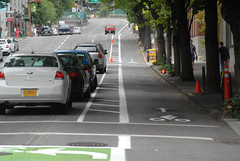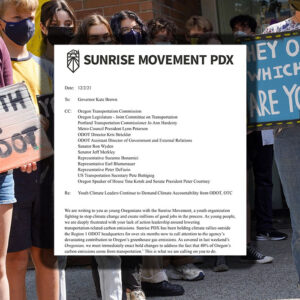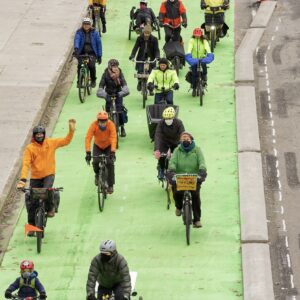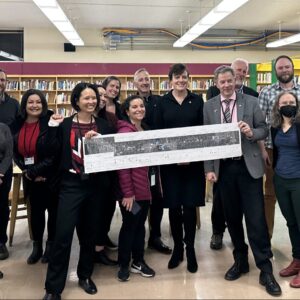Bikes Belong has just announced that Portland has been selected as one of six “focus cities” to participate in their Green Lane Project.
The other cities that will join Portland are: Austin, Texas; Chicago, Illinois; Memphis, Tennessee; San Francisco, California; and Washington, D.C.. These cities were chosen from a pool of 42 applicants.
About the selection, project leader Martha Roskowski said via a statement, “We are delighted to be working with these forward-thinking cities. They are a range of sizes, spread across the country, and at various stages in terms of developing networks for bicycles. What they share is a strong commitment to rethinking how city streets are used and making room for bicycles.”
The impetus behind the Green Lane Project is to hasten the implementation of world-class bike facilities — like cycle tracks, and other protected bikeways — in U.S. cities. While Portland and other cities are dabbling in protected lanes and other bike-centric road designs, no city has yet built a truly world-class, connected, safe and comfortable network of bikeways that rivals what we see in top European cycling cities. Through this project, Bikes Belong won’t fund any projects; but they will, “provide resources and technical assistance to help the six focus cities accomplish their goals of creating this type of protected space for people on bikes.”
In the next two months, Green Lane Project staff will work with local elected officials, City staff, and advocacy groups to iron out details. A big announcement of each city’s vision and goals will be released at a national kickoff event in Chicago in late May. GreenLaneProject.org will become a hub for all U.S. cities (not just the ones selected) to share experiences and learn from each other.
If you’re wondering why New York City — the U.S. leaders in protected bikeways — wasn’t chosen, it’s worth noting that the NYC DOT is a senior advisor to the program.
The selection of Portland comes with a sigh of relief. Some observers thought Bikes Belong wouldn’t select us, due to the (mistaken in my opinion) perception that we already have plenty of momentum for this type of thing. The truth is, we need all the help we can get. Despite being one of the pioneers in bikeway development, Portland has not kept pace with other cities in developing protected bikeways in the urban core. Perhaps the biggest benefit this project will provide for us, in addition to a kick-in-the-pants and important national visibility, is a reaffirmation of the need for better bikeways just as we settle into a new mayor and new City Council members.
In Portland we are experiencing that it can be very difficult to go from good to great. I hope this project helps us get over that hump.
For more on the Green Lane Project, watch the video below:
Green Lane Project from Bikes Belong on Vimeo.






I think this is all good (except the everyone-flies-to-Chicago-in-May part), but I do also wish there were a parallel effort afoot that took seriously the challenge of the phaseout of our reliance on automobiles in our lifetimes, and explored what our infrastructure could and should look like when that comes to pass.
The two visions: accommodate bikes that now or soon may make up ~10% mode share, and how do we get around when cars have shriveled to ~10% mode share are not the same when it comes to infrastructure priorities. Asphalt and the rest of our infrastructure lasts a long time (especially if Jeff Bernards prevails). No need to pretend the car is going to be with us forever.
At the risk of seeming dense, what do we need to change for cars to fall to 10% mode share? It seems to me that instead of having a single bike lane, roads can just gradually shift to 2 bike lanes, 3 bike lanes, and then eventually the whole road will be for bikes, with a crappy little lane at the left side for cars, that’s will be too narrow for 2 vehicles to pass each other and full of street sweeping debris.
An incremental adjustment is certainly conceivable and may be how it turns out. My reasons for wanting the parallel discussion are as follows –
(1) that discussion itself validates the issue, concretizes what lies ahead, allows us to start planning for it (individuals and the city), and as such can ease and even accelerate the shift (all good things in my view)
(2) Regularly redoing the expensive, incremental adjustments we’re performing now to make things better for bikes, at the mode share we currently have, as cars fade and bikes take over is not efficient, or a good use of funds in my view without a plan that anticipates this steady erosion of cardom. It may be as you say that what we’re doing is so modular that we can chip away lane by lane, but I suspect that in the real world it isn’t nearly that easy to imagine working, much less working well.
(3) A serious long term vision for how non-car modes will take over from cars to me would look, smell, taste very different from what I believe we have now, the blueprints we’re working from. Many of the projects (CRC?, Sellwood Bridge replacement, Couch circus, etc) might look very different with this framing rather than the one we now use. Why not get ahead of the game? Wouldn’t that be an approach that deserved the monikers ‘forward-thinking’ or ‘world class’ or ‘kick in the pants’?
I am under no illusions that this is *not* a big step from the conversations we now have. But I don’t think there’s anything to be gained from *not* having this conversation alongside the one we’re already familiar with.
Peak Car may have already arrived in London
http://www.independent.co.uk/life-style/motoring/features/is-this-the-end-of-the-car-2286616.html
“Between 1992 and 2007, the number of 17- to 20-year-olds who held licences fell from 48 per cent to 38 per cent, and for 21- to 29-year-olds, the number fell from 75 per cent to 66 per cent….between 2004 and 2008, car trips per person went down by 9 per cent and car distance per person by 5 per cent.”
Awesome. I vote for a cycle track conversion of NE Killingsworth past 42nd. The road is so wide, I bet they could do a PSU style parking protected cycle track without removing vehicle capacity. This would dramatically improve the experience for pedestrians and residents living nearby
As long as we’re voting… I think Sandy Blvd is the next frontier. That street has way more car capacity than it needs and it’s just dying to become a main bike thoroughfare.
Sandy would be amazing, because it is the most direct and level route between outer NE and downtown, and currently is totally hostile to bikes. I sort of forget it exists, since it is no use to me.
However, I also think Sandy could be a great route for rapid transit, whether limited-stop buses with bus lanes and stations (i.e. “BRT”) or light rail. In Hollywood and some other areas the roadway is 60 feet wide, which makes it hard to fit buses, cars and bikes in the same right-of-way.
Perhaps it could be a transit, bike and pedestrian-only street thru the narrowest part in Hollywood, and cars could detour thru the grid on Halsey and 4th, as was done in New York on Broadway. (Most of the route has 70 or 80 feet of roadway, wide enough for cycletracks, car lanes and transit lanes, if parking is removed)
Since we’re building a wishlist: I would love better routes for going north and south on the eastside.
What about the SW? Barbur and Beaverton-Hillsdale defintely need improvement, Capitol Hwy is right behind. After all SW Portland is still mostly a mess for biking. (Oh and can you erase the hills too, while you are at it?)
What did the hills ever do to you, except reduce your risk for heart disease… 😉 I do agree with you. Beaverton-Hillsdale is a cluster#*@! from HWY 217 and past Hillsdale. How about that bridge below Terwilliger that puts you onto Barbur? And Terwilliger, which should be a pleasant route, can suck when cars are attempting freeway speeds. Some traffic calming would be appreciated. Capitol can be downright frightening on your way up to Barbur, since there is no shoulder or bike lane and some blind corners. That whole area can suck for commuting. I used to go over Council Crest just to avoid Barbur.
Maybe this Project can illustrate some of these issues more clearly to people who think we’ve ‘got it made’ here in Portland.
Agreed. This is one of my pet peeves, and I’m on the verge of writing ODOT a letter, since I regularly ride through SW on my way home from Beaverton. Several sections of Beaverton-Hillsdale’s bike lane are overgrown with vegetation (2 places on the inside of curves where cars hug the white line), the section in front of Key Bank by Oleson/Scholls Ferry (which JUST got redone!) has the skinniest bike lane in existence, west of Scholls Ferry the road has enough pavement for bike lanes but they come and go. It could be so much better.
Will these guys be working with ODOT too … or only PBOT? Many of the examples given above — Sandy, Barbur, Beav-Hillsdale, for example — are designated state highways and thus under ODOT’s neglectful jurisdiction.
Burnside, Burnside, Burnside… from SE 71st to the West Hills…
I like the Sandy idea too.
Let’s pick a major underserved corridor.
Oh man. Great. As other cities pick up steam, we need to have injections like this if we are to keep apace. Anything more than just paint on the road is necessary if Portland is going to remain the vanguard.
Sandy is begging for a major redesign. On the SE side, Foster Rd is similar to Sandy blvd in that it cuts through a large swath of land at an odd angle. It is also used in excess for car capacity and poorly designed for all other uses. Many of us in Lents call it the Happy Valley Highway.
Sandy +1
Burnside +1
Ummmm…Memphis, TN!? I lived there in the late 90’s and I know that’s a long time ago, but forward thinking and bike friendly aren’t things I remember about Memphis. What I remember is the smile on my face the day I left!
+100 for the Sandy Blvd idea.
That street could definately use a redisign that incorporates more modes of transit and it seems like it would be fairly easy to do so.
I’m willing to bet the businesses along that street would welcome modes of traffic that get people out of cars and into their shops.
Austin, Texas?